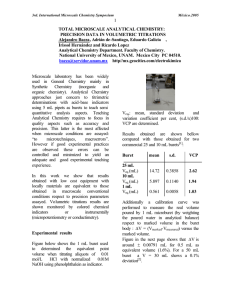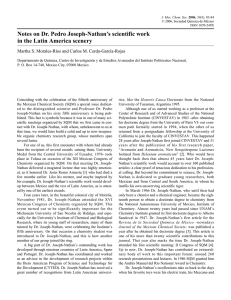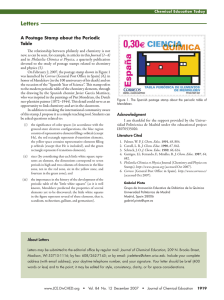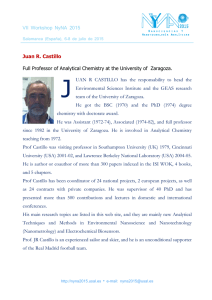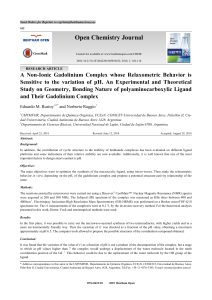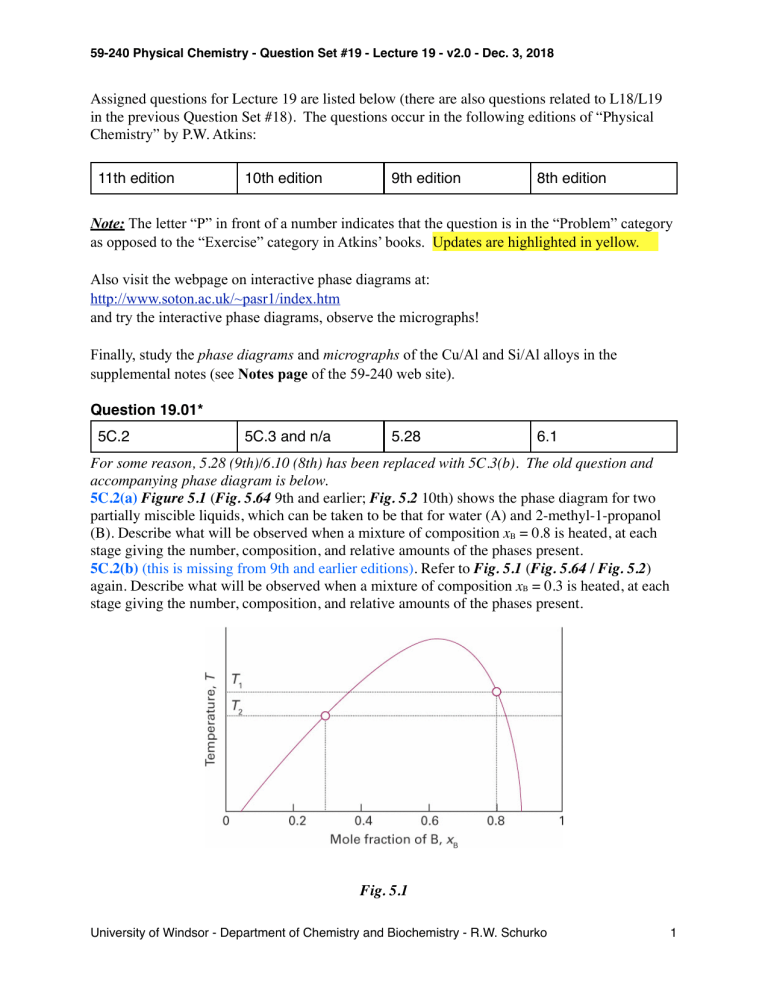
59-240 Physical Chemistry - Question Set #19 - Lecture 19 - v2.0 - Dec. 3, 2018 Assigned questions for Lecture 19 are listed below (there are also questions related to L18/L19 in the previous Question Set #18). The questions occur in the following editions of “Physical Chemistry” by P.W. Atkins: 11th edition 10th edition 9th edition 8th edition Note: The letter “P” in front of a number indicates that the question is in the “Problem” category as opposed to the “Exercise” category in Atkins’ books. Updates are highlighted in yellow. Also visit the webpage on interactive phase diagrams at: http://www.soton.ac.uk/~pasr1/index.htm and try the interactive phase diagrams, observe the micrographs! Finally, study the phase diagrams and micrographs of the Cu/Al and Si/Al alloys in the supplemental notes (see Notes page of the 59-240 web site). Question 19.01* 5C.2 5C.3 and n/a 5.28 6.1 For some reason, 5.28 (9th)/6.10 (8th) has been replaced with 5C.3(b). The old question and accompanying phase diagram is below. 5C.2(a) Figure 5.1 (Fig. 5.64 9th and earlier; Fig. 5.2 10th) shows the phase diagram for two partially miscible liquids, which can be taken to be that for water (A) and 2-methyl-1-propanol (B). Describe what will be observed when a mixture of composition xB = 0.8 is heated, at each stage giving the number, composition, and relative amounts of the phases present. 5C.2(b) (this is missing from 9th and earlier editions). Refer to Fig. 5.1 (Fig. 5.64 / Fig. 5.2) again. Describe what will be observed when a mixture of composition xB = 0.3 is heated, at each stage giving the number, composition, and relative amounts of the phases present. Fig. 5.1 University of Windsor - Department of Chemistry and Biochemistry - R.W. Schurko 1 59-240 Physical Chemistry - Question Set #19 - Lecture 19 - v2.0 - Dec. 3, 2018 5.28(b) Figure 5.65 (9th and earlier editions) is the phase diagram for silver and tin. Label the regions, and describe what will be observed when liquids of compositions a and b are cooled to 200 K. Fig. 5.65 University of Windsor - Department of Chemistry and Biochemistry - R.W. Schurko 2 59-240 Physical Chemistry - Question Set #19 - Lecture 19 - v2.0 - Dec. 3, 2018 Question 19.02* 5D.4 5C.4 5.29 6.11 Same questions in all editions. 5D.4(a) Indicate on the phase diagram in Fig. 5.4 (Fig. 5.3, 10th; Fig. 5.66, 9th) the feature that denotes incongruent melting. What is the composition of the eutectic mixture and at what temperature does it melt? Fig. 5.4: 5D.4(b) Indicate on the phase diagram in Fig. 5.5 (Fig. 5.4, 10th; Fig. 5.67, 9th) the feature that denotes incongruent melting. What are the compositions of any eutectic mixtures and at what temperatures do they melt? Fig. 5.5: University of Windsor - Department of Chemistry and Biochemistry - R.W. Schurko 3 59-240 Physical Chemistry - Question Set #19 - Lecture 19 - v2.0 - Dec. 3, 2018 Question 19.03* 5D.5 5C.5 5.3 6.12 Same questions in all editions. 5D.5(a) Sketch the cooling curves for the isopleths a and b in Fig. 5.4 (Fig. 5.3 10th; Fig. 5.66, 9th; Fig 6.41 8th) 5D.5(b) Sketch the cooling curves for the isopleths a and b in Fig. 5.5 (Fig. 5.67, 9th; Fig 6.42 8th) Question 19.04* 5D.6 5C.6 5.31 6.13 Same questions in all editions. 5D.6(a) Use the phase diagram in Fig. 5.4 (Fig. 5.3, 10th; Fig. 5.65, 9th; 6.40 8th) to state (i) the solubility of Ag in Sn at 800 °C and (ii) the solubility of Ag3Sn in Ag at 460 °C, (iii) the solubility of Ag3Sn in Ag at 300 °C. 5D.6(b) Use the phase diagram in Fig. 5.5 (Fig. 5.3, 10th; Fig. 5.66, 9th; 6.41 8th) to state (i) the solubility of B in A at 500 °C and (ii) the solubility of B in A at 390 °C, (iii) the solubility of AB2 in B at 300 °C. Question 19.05* P5C.5, P5D.1 5C.7 5.32 6.14 Same questions in all editions. P5C.5 Figure 5.2 (Fig. 5.5, 10th; 5.68, 9th; 6.43 8th) shows the experimentally determined phase diagrams for the nearly ideal solution of hexane and heptane. (i) Label the regions of the diagrams to which phases are present. (ii) For a solution containing 1 mol each of hexane and heptane molecules, estimate the vapour pressure at 70 °C when vaporization on reduction of the external pressure just begins. (iii) What is the vapour pressure of the solution at 70 °C when just one drop of liquid remains. (iv) Estimate from the figures the mole fraction of hexane in the liquid and vapour phases for the conditions of part b. (v) What are the mole fractions for the conditions of part c? (vi) At 85 °C and 760 Torr, what are the amounts substance in the liquid and vapour phases when zheptane = 0.40? (see next page) University of Windsor - Department of Chemistry and Biochemistry - R.W. Schurko 4 59-240 Physical Chemistry - Question Set #19 - Lecture 19 - v2.0 - Dec. 3, 2018 Fig. 5.2 P5D.1 Uranium tetrafluoride and zirconium tetrafluoride melt at 1035 °C and 912 °C respectively. They form a continuous series of solid solutions with a minimum melting temperature of 765 °C and composition x(ZrF4) = 0.77. At 900 °C, the liquid solution of composition x(ZrF4) = 0.28 is in equilibrium with a solid solution of composition x(ZrF4) = 0.14. At 850 °C the two compositions are 0.87 and 0.90, respectively. Sketch the phase diagram for this system and state what is observed when a liquid of composition x(ZrF4) = 0.40 is cooled slowly from 900 °C to 500 °C. University of Windsor - Department of Chemistry and Biochemistry - R.W. Schurko 5 59-240 Physical Chemistry - Question Set #19 - Lecture 19 - v2.0 - Dec. 3, 2018 Question 19.06* 5D.2 5C.8 5.33 6.15 Same questions in 10th and earlier editions. Missing from 11th ed. for some reason. 5D.2(a) Methane (melting point 91 K) and tetrafluoromethane (melting point 89 K) do not form solid solutions with each other, and as liquids they are only partially miscible. The upper critical temperature of the liquid mixture is 94 K at x(CF4) = 0.43 and the eutectic temperature is 84 K at x(CF4) = 0.88. At 86 K, the phase in equilibrium with the tetrafluoromethane-rich solution changes from solid methane to a methane-rich liquid. At that temperature, the two liquid solutions that are in mutual equilibrium have the compositions x(CF4) = 0.10 and x(CF4) = 0.80. Sketch the phase diagram. 5D.2(b) Describe the phase changes that take place when a liquid mixture of 4.0 mol B2H6 (melting point 131 K) and 1.0 mol CH3OCH3 (melting point 135 K) is cooled from 140 K to 90 K. These substances form a compound (CH3)2OB2H6 that melts congruently at 133 K. The system exhibits one eutectic at x(B2H6) = 0.25 and 123 K and another at x(B2H6) = 0.90 and 104 K. Question 19.07* 5D.3 5C.9 5.34 6.16 Same questions in all editions. 5D.3(a) Refer to the information in Exercise 5D.2(a) (5C.8(a), 10th; 5.33(a), 9th; 6.15(a), 8th) and sketch the cooling curves for liquid mixtures in which x(CF4) is (i) 0.10, (ii) 0.30, (iii) 0.50, (iv) 0.80, and (v) 0.95. 5D.3(b) Refer to the information in Exercise 5D.2(b) (5C.8(b), 10th; 5.33(b), 9th; 6.15(b), 8th) and sketch the cooling curves for liquid mixtures in which x(B2H6) is (i) 0.10, (ii) 0.30, (iii) 0.50, (iv) 0.80, and (v) 0.95. Question 19.08* 5C.4 5C.10 5.35 6.17 Same questions in all editions. 5C.4(a) Hexane and perfluorohexane show partial miscibility below 22.70 °C. The critical concentration at the upper critical temperature is x = 0.355, where x is the mole fraction of C6F14. At 22.0 °C the two solutions in equilibrium have x = 0.24 and x = 0.48, respectively, and at 21.5 °C the mole fractions are 0.22 and 0.51. Sketch the phase diagram. Describe the phase changes that occur when perfluorohexane is added to a fixed amount of hexane at (i) 23 °C, (ii) 22 °C. 5C.4(b) Two liquids, A and B, show partial miscibility below 52.4 °C. The critical concentration at the upper critical temperature is x = 0.459, where x is the mole fraction of A. At 40.0 °C the two solutions in equilibrium have x = 0.22 and x = 0.60, respectively, and at 42.5 °C the mole fractions are 0.24 and 0.48. Sketch the phase diagram. Describe the phase changes that occur when B is added to a fixed amount of A at (i) 48 °C, (ii) 52.4 °C. University of Windsor - Department of Chemistry and Biochemistry - R.W. Schurko 6 59-240 Physical Chemistry - Question Set #19 - Lecture 19 - v2.0 - Dec. 3, 2018 Answer 19.01* 5C.2 5C.3 and n/a 5.28 6.1 For some reason, 5.28 (9th)/6.10 (8th) has been replaced with 5C.3(b). The old question and accompanying phase diagram is below. University of Windsor - Department of Chemistry and Biochemistry - R.W. Schurko 7 59-240 Physical Chemistry - Question Set #19 - Lecture 19 - v2.0 - Dec. 3, 2018 Answer 19.02* 5D.4 5C.4 5.29 6.11 Same questions in all editions. University of Windsor - Department of Chemistry and Biochemistry - R.W. Schurko 8 59-240 Physical Chemistry - Question Set #19 - Lecture 19 - v2.0 - Dec. 3, 2018 Answer 19.03* 5D.5 5C.5 5.3 6.12 Same questions in all editions. University of Windsor - Department of Chemistry and Biochemistry - R.W. Schurko 9 59-240 Physical Chemistry - Question Set #19 - Lecture 19 - v2.0 - Dec. 3, 2018 Answer 19.04* 5D.6 5C.6 5.31 6.13 Same questions in all editions. University of Windsor - Department of Chemistry and Biochemistry - R.W. Schurko 10 59-240 Physical Chemistry - Question Set #19 - Lecture 19 - v2.0 - Dec. 3, 2018 University of Windsor - Department of Chemistry and Biochemistry - R.W. Schurko 11 59-240 Physical Chemistry - Question Set #19 - Lecture 19 - v2.0 - Dec. 3, 2018 Answer 19.05* P5C.5, P5D.1 5C.7 5.32 6.14 Same questions in all editions. University of Windsor - Department of Chemistry and Biochemistry - R.W. Schurko 12 59-240 Physical Chemistry - Question Set #19 - Lecture 19 - v2.0 - Dec. 3, 2018 University of Windsor - Department of Chemistry and Biochemistry - R.W. Schurko 13 59-240 Physical Chemistry - Question Set #19 - Lecture 19 - v2.0 - Dec. 3, 2018 Answer 19.06* 5D.2 5C.8 5.33 6.15 Same questions in all editions. ! University of Windsor - Department of Chemistry and Biochemistry - R.W. Schurko 14 59-240 Physical Chemistry - Question Set #19 - Lecture 19 - v2.0 - Dec. 3, 2018 ! University of Windsor - Department of Chemistry and Biochemistry - R.W. Schurko 15 59-240 Physical Chemistry - Question Set #19 - Lecture 19 - v2.0 - Dec. 3, 2018 Answer 19.07* 5D.3 5C.9 5.34 6.16 Same questions in all editions. University of Windsor - Department of Chemistry and Biochemistry - R.W. Schurko 16 59-240 Physical Chemistry - Question Set #19 - Lecture 19 - v2.0 - Dec. 3, 2018 Answer 19.08* 5C.4 5C.10 5.35 6.17 Same questions in all editions. University of Windsor - Department of Chemistry and Biochemistry - R.W. Schurko 17


